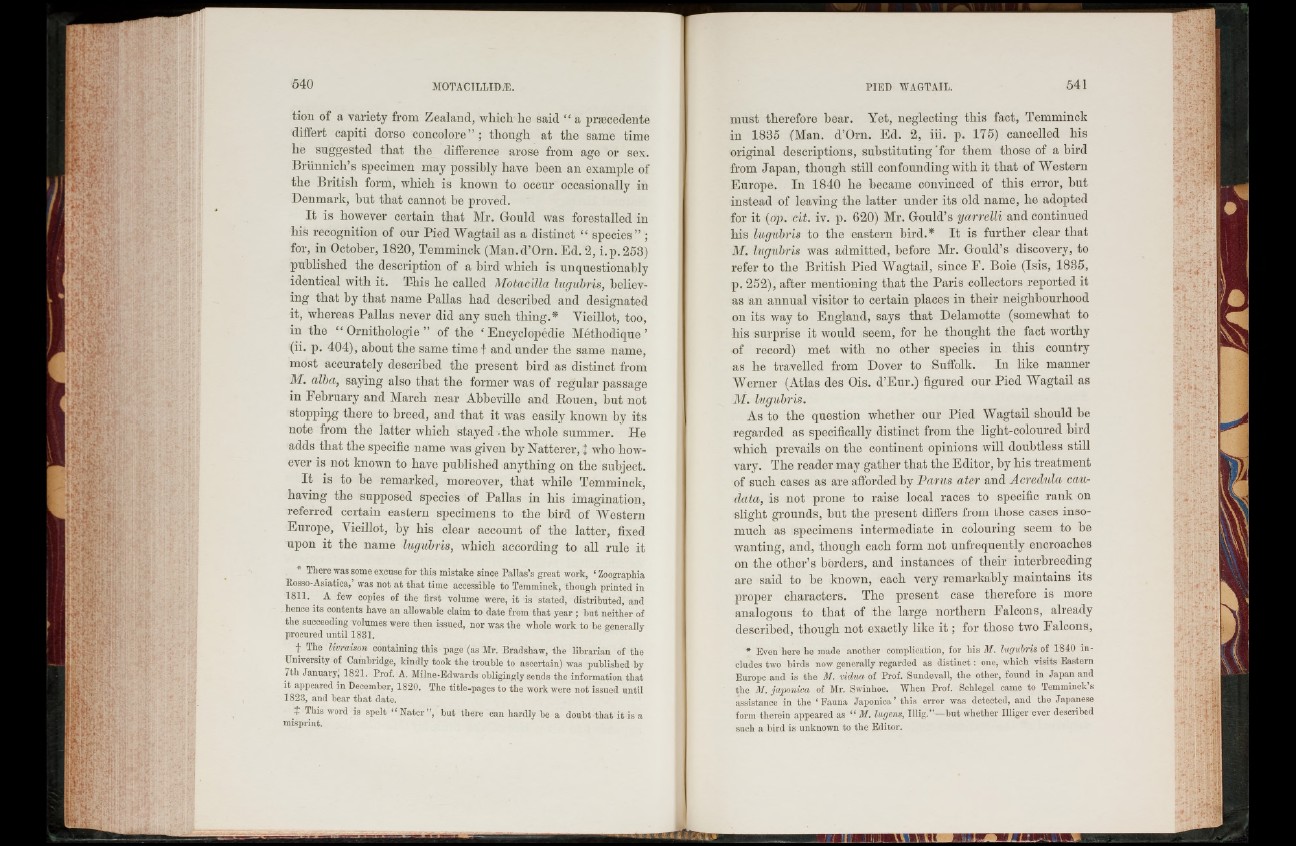
tion of a variety from Zealand, which he said “ a præcedente
differt capiti dorso concolore” ; though at the same time
he suggested that the difference arose from age or sex.
Briinnicli’s specimen may possibly have been an example of
the British form, which is known to occur occasionally in
Denmark, but that cannot he proved.
I t is however certain that Mr. Gould was forestalled in
his recognition of our Pied Wagtail as a distinct “ species” ;
for, in October, 1820, Temminck (Man.d’Orn. Ed. 2, i.p.253)
published the description of a bird which is unquestionably
identical with it. T-his lie called Motacilla lugubris, believing
that by that name Pallas had described and designated
it, whereas Pallas never did any such thing.* Vieillot, too,
in the “ Ornithologie ” of the * Encyclopédie Méthodique ’
(ii. p. 404), about the same time t and under the same name,
most accurately described the present bird as distinct from
M. alba, saying also that the former was of regular passage
in February and March near Abbeville and Rouen, but not
stopping there to breed, and that it was easily known by its
note from the latter which stayed - the whole summer. He
adds that the specific name was given by Natterer, Î who however
is not known to have published anything on the subject.
I t is to be remarked, moreover, that while Temminck,
having the supposed species of Pallas in his imagination,
referred certain eastern specimens to the bird of Western
Europe, Vieillot, by his clear account of the latter, fixed
upon it the name lugubris, which according to all rule it
There was some excuse for this mistake since Pallas’s great work, ‘ Zoographia
Rosso-Asiatica, was not at that time accessible to Temminck, though printed in
1811. ^ A few copies of the first volume were, it is stated, distributed, and
hence its contents have an allowable claim to date from that year ; but neither of
the succeeding volumes were then issued, nor was the whole work to be generally
procured until 1831.
f The livraison containing this page (as Mr. Bradshaw, the librarian of the
University of Cambridge, kindly took the trouble to ascertain) was published by
7th January, 1821. Prof. A. Milne-Edwards obligingly sends the information that
it appeared in December, 1820. The title-pages to the work were not issued until
1823, and bear that date.
Î This word is spelt “ Nater”, but there can hardly be a doubt that it is a
misprint.
must therefore bear. Yet, neglecting this fact, Temminck
in 1835 (Man. d’Orn. Ed. 2, iii. p. 175) cancelled his
original descriptions, substituting'for them those of a bird
from Japan, though still confounding with it that of Western
Europe. In 1840 he became convinced of this error, but
instead of leaving the latter under its old name, he adopted
for it {op. cit. iv. p. 620) Mr. Gould’s yarrelli and continued
his lugubris to the eastern bird.* I t is further clear that
M. lugubris was admitted, before Mr. Gould’s discovery, to
refer to the British Pied Wagtail, since F. Boie (Isis, 1835,
p. 252), after mentioning that the Paris collectors reported it
as an annual visitor to certain places in their neighbourhood
on its way to England, says that Delamotte (somewhat to
his surprise it would seem, for lie thought the fact worthy
of record) met with no other species in this country
as lie travelled from Dover to Suffolk. In like manner
Werner (Atlas des Ois. d’Eur.) figured our Pied Wagtail as
M. lugubris.
As to the question whether our Pied Wagtail should be
regarded as specifically distinct from the light-coloured bird
which prevails on the continent opinions will doubtless still
vary. The reader may gather that the Editor, by his treatment
of such cases as are afforded by Parus ater and Acrecíala cau-
data, is not prone to raise local races to specific rank on
slight grounds, but the present differs from those cases insomuch
as specimens intermediate in colouring seem to be
wanting, and, though each form not unfrequently encroaches
on the other’s borders, and instances of their interbreeding
are said to be known, each very remarkably maintains its
proper characters. The present case therefore is more
analogous to that of the large northern Falcons, already
described, though not exactly like i t ; for those two Falcons,
* Even here he made another complication, for his M. lugubris of 1840 in cludes
two birds now generally regarded as distinc t: one, which visits Eastern
Europe and is the M. vidua of Prof. Sundevall, the other, found in Japan and
the M. japónica of Mr. Swinhoe. When Prof. Schlegel came to Temminck’s
assistance in the ‘ Fauna Japónica’ this error was detected, and the Japanese
form therein appeared as “ M. lugens, Ulig.”—but whether Illiger ever described
such a bird is unknown to the Editor.